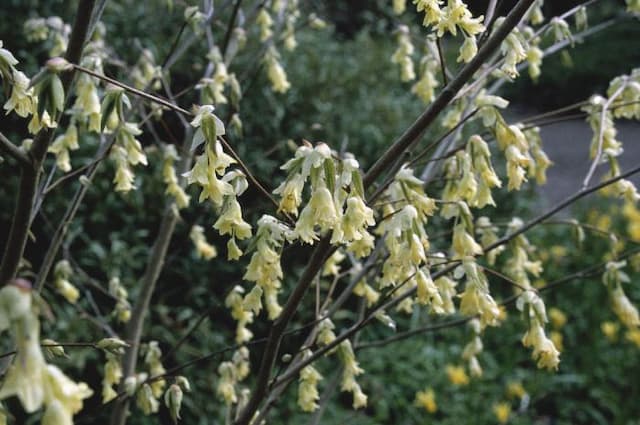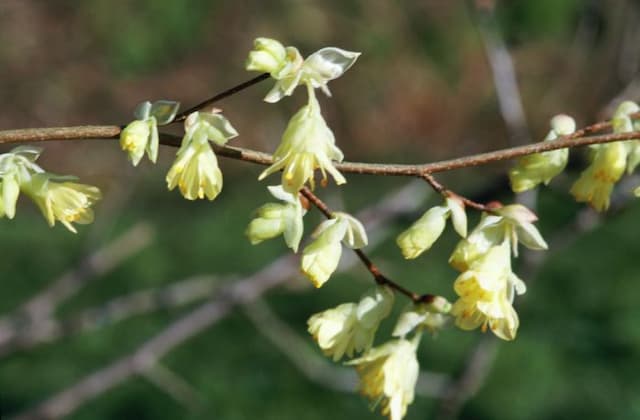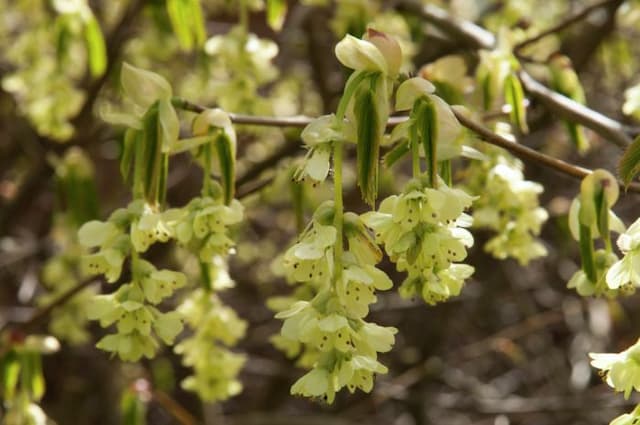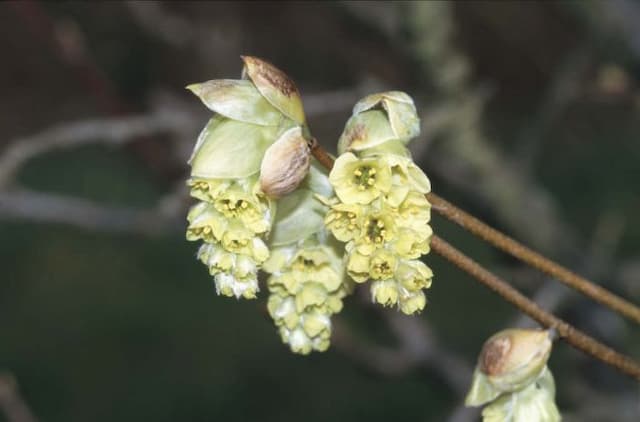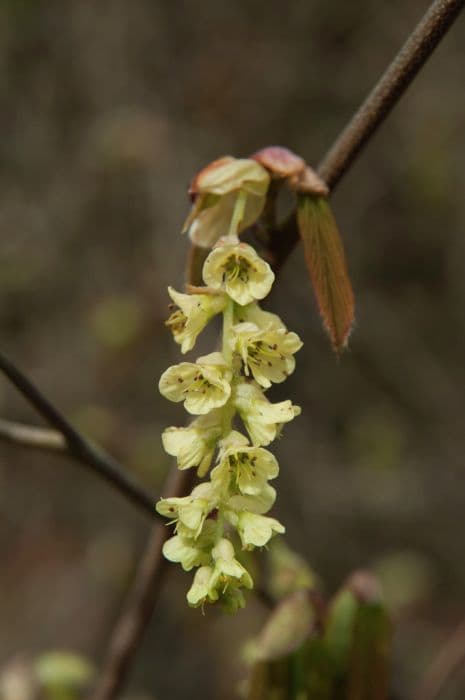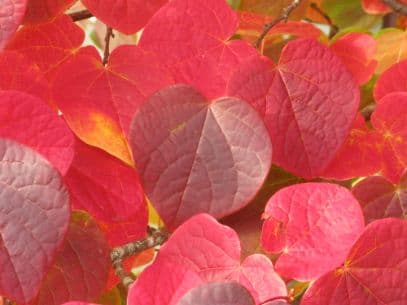Witch Hazel Hamamelis × intermedia 'Alexander'

ABOUT
The plant known as Witch Hazel 'Alexander' is a visually striking shrub that displays distinctive characteristics, making it a favorite among gardening enthusiasts. It typically features a multi-stemmed and broadly spreading habit, giving it a full and robust appearance. Its leaves are eye-catching, with a broadly ovate shape and a tendency to turn from green to vivid shades of yellow, orange, and red in the fall, providing a spectacular splash of autumn color. One of the most remarkable aspects of Witch Hazel 'Alexander' is its flowers. Blooming in the late winter to early spring, the flowers are ribbon-like with a unique, spidery form. The petals are vibrant yellow with red bases, which stand out against the wintry backdrop of bare branches or the last traces of snow. The contrast is particularly dramatic in the quiet months before most other plants have begun to show signs of new life. Additionally, these flowers are not only a visual delight but also emit a pleasant fragrance that can be a welcome olfactory surprise in the cool air of its flowering season. The bark of the Witch Hazel 'Alexander' is smooth and gray-brown, providing a simple yet attractive texture that complements its year-round appeal. As the seasons change, the structure of the shrub, especially when devoid of leaves, adds an element of architectural interest to the landscape, with its woody stems creating a distinctive silhouette. This attribute is especially appreciated during the winter months when the intricate branching pattern is on full display. Overall, Witch Hazel 'Alexander' is valued for its seasonal interest, starting with fragrant, colorful flowers in the quiet months of late winter, followed by striking fall foliage, and finishing with a structural form that provides winter interest. Its capability to deliver beauty throughout the seasons makes it a standout plant in the garden.
About this plant
 Names
NamesFamily
Hamamelidaceae
Synonyms
Alexander Witch Hazel
Common names
Hamamelis × intermedia 'Alexander'.
 Toxicity
ToxicityTo humans
Witch Hazel, specifically the cultivar Hamamelis × intermedia 'Alexander', is generally considered non-toxic to humans. There are no widespread reports of poisoning from consuming parts of this plant. However, it is advisable to avoid ingesting plant material that is not commonly recognized as food, as it could cause mild stomach upset or an allergic reaction in sensitive individuals.
To pets
Witch Hazel, specifically the cultivar Hamamelis × intermedia 'Alexander', is also generally regarded as non-toxic to pets. Similarly, to its effects on humans, ingestion of this plant by pets is not commonly associated with poisoning and is unlikely to cause serious harm. However, it's always prudent to prevent pets from eating ornamental plants as they might cause mild gastrointestinal upset or present an allergy risk to some animals.
 Characteristics
CharacteristicsLife cycle
Perennials
Foliage type
Deciduous
Color of leaves
Green
Flower color
Yellow
Height
12 feet (3.66 meters)
Spread
12 feet (3.66 meters)
Plant type
Shrub
Hardiness zones
5
Native area
Japan China
Benefits
 General Benefits
General Benefits- Aesthetic Appeal: Adds visual interest to the garden with its vibrant flowers and foliage.
- Seasonal Interest: The plant blooms in late winter to early spring, providing color during a typically dull time in the garden.
- Attracts Wildlife: Flowers provide nectar for pollinators such as bees during the early season when few other food sources are available.
- Drought Tolerance: Once established, it can tolerate periods of low water, making it suitable for xeriscaping.
- Low Maintenance: Requires minimal care once established, making it a good choice for gardeners of all skill levels.
- Cold Hardy: Can withstand cold temperatures, making it suitable for gardens in cooler climates.
- Adaptable: Able to grow in a range of soil types, though it prefers well-draining, acidic soils.
 Medical Properties
Medical PropertiesThis plant is not used for medical purposes.
 Air-purifying Qualities
Air-purifying QualitiesThis plant is not specifically known for air purifying qualities.
 Other Uses
Other Uses- Witch Hazel branches can be used to create a distinctive, fragrant kindling for fireplaces, offering a pleasant aroma when burned.
- When dried, Witch Hazel's ornamental seed pods can serve as a unique addition to floral arrangements or craft projects.
- Due to its dense form, Witch Hazel can be utilized to create privacy screens or living fences in residential gardens.
- The yellow to red vibrant foliage of Witch Hazel provides stunning natural dyes for fabrics when boiled down to extract color.
- Witch Hazel's strong wood can be carved into small woodworking projects like utensils, specialty tools, or decorative sculptures.
- The leaves of Witch Hazel, once dried, can be used to stuff small scented pillows or sachets for a subtle fragrance.
- Photographers and painters often use Witch Hazel as a picturesque subject due to its twisted branches and radiant winter flowers.
- Enthusiasts of bonsai may use Witch Hazel as an attractive plant for creating miniature landscapes due to its interesting structure and foliage.
- Birdwatchers might incorporate Witch Hazel into their landscapes to attract specific bird species that feed on its fruits during the fall season.
- During fall, the foliage of Witch Hazel can be collected and pressed to create artistic leaf pressings for decoration or craft purposes.
Interesting Facts
 Feng Shui
Feng ShuiThe Witch Hazel is not used in Feng Shui practice.
 Zodiac Sign Compitability
Zodiac Sign CompitabilityThe Witch Hazel is not used in astrology practice.
 Plant Symbolism
Plant Symbolism- Healing: Like other witch hazel varieties, Hamamelis × intermedia 'Alexander', commonly known as witch hazel, symbolizes healing due to its medicinal properties and use in traditional remedies.
- Protection: Witch hazel has been associated with protection since it was commonly used by Native Americans to craft divining rods, which were believed to guard against evil spirits and harmful influences.
- Nature’s resilience: Blooming in late winter, witch hazel represents nature’s resilience and the ability to thrive even in harsh conditions.
 Water
WaterWitch Hazel 'Alexander' should be watered deeply when the top few inches of soil feel dry, which generally amounts to once a week. In the growing season, increase watering to maintain even soil moisture, while in winter reduce it as plant needs decrease. Each watering should be thorough, allowing water to penetrate at least 12 inches into the ground. For a newly planted Witch Hazel, this might mean using 2-3 gallons of water per week while established plants in dry conditions may require up to 5 gallons. Always water at the base of the plant to avoid wetting the foliage, which can lead to disease.
 Light
LightWitch Hazel 'Alexander' thrives in full sun to partial shade. The plant will grow most vigorously and flower best when it receives at least 4 hours of direct sunlight daily. An ideal spot would be one where the morning sun can reach the plant, while providing some shade during the harshest afternoon light to prevent scorching of the leaves.
 Temperature
TemperatureWitch Hazel 'Alexander' is hardy and can withstand a range of temperatures, with ideal growing conditions between 30°F and 75°F. It can survive minimum winter temperatures down to -20°F, making it suitable for USDA zones 5 through 8. During extreme summer heat above 90°F, it’s important to provide adequate water to prevent stress.
 Pruning
PruningPrune Witch Hazel 'Alexander' immediately after flowering, which typically is in late winter or early spring, to maintain shape and encourage vigorous growth. Remove any dead or crossed branches and thin out as needed to improve air circulation. Pruning is not strictly necessary every year, but periodic maintenance can help keep the plant healthy and visually appealing.
 Cleaning
CleaningAs needed
 Soil
SoilWitch Hazel 'Alexander' thrives in well-draining soil that is rich in organic matter. The ideal pH for this plant is between 5.5 and 6.5. A good soil mix can be made with equal parts loam, peat, and sharp sand to ensure proper drainage and fertility.
 Repotting
RepottingWitch Hazel 'Alexander' does not need frequent repotting and can usually be repotted every 3 to 5 years, as it prefers to be slightly root-bound.
 Humidity & Misting
Humidity & MistingWitch Hazel 'Alexander' prefers moderate humidity but is quite adaptable and can tolerate the varying humidity levels typically found in outdoor garden settings.
 Suitable locations
Suitable locationsIndoor
Ensure bright light, cool temps, and moist, well-draining soil.
Outdoor
Plant in partial shade, use moist, fertile, acidic soil.
Hardiness zone
5-8 USDA
 Life cycle
Life cycleThe Witch Hazel 'Alexander' typically begins its life cycle when a seed germinates in late spring after a period of cold stratification. Seedlings then develop into juvenile plants, gradually maturing over several years, forming a multi-stemmed shrubby growth habit. It reaches reproductive maturity within 4 to 5 years, beginning to produce fragrant yellow flowers that bloom in late winter to early spring before the leaves emerge. These flowers are followed by the development of seed capsules that mature in autumn. The capsules then explosively discharge seeds which can distribute several meters away from the parent plant. The Witch Hazel 'Alexander' can live for many years, during which it continues to undergo cycles of growth, flowering, and seed production.
 Propogation
PropogationPropogation time
Late Winter
The Witch Hazel 'Alexander' can be effectively propagated through semi-hardwood cuttings, which is a popular method for this plant. Semi-hardwood cuttings are taken from the current season's growth, which has begun to mature but is not fully hardened; this typically occurs in late summer to early autumn. Cuttings should be about 4 to 6 inches (10 to 15 centimeters) in length and include several leaf nodes. The bottom end of the cutting is usually dipped in rooting hormone to enhance root development and then placed in a well-draining medium such as a mix of peat and perlite. The cuttings should be kept in a humid environment with indirect light until roots have developed, which can take several weeks. Once rooted, they can be gradually acclimatized to outdoor conditions before planting in their permanent location.
